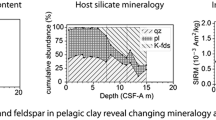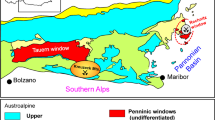Abstract
Partially turbid alkali feldspars from hydrothermally altered Tertiary granites on the Isle of Skye (the Red Hills granites) were studied using light microscopy, scanning and transmission electron microscopies, and energy-dispersive X-ray spectroscopy. Limpid cores and turbid rims of individual crystals were compared to determine the causes of the turbidity. The limpid cores were cryptoperthitic, with lamellar widths of 0.1–0.3 μm. In contrast, the turbid rims contained K-rich and Narich areas coarsened to >0.5 μm. Turbid regions contained abundant inclusions, whereas limpid regions did not. Two generations of turbidity were recognized. Feldspars from the Beinn an Dubhaich granite, a granite with near-normal values for 18O/16O possessed limpid cores surrounded by turbid rims that cast a reddish-brown hue in transmitted light. When viewed in darkfield light microscopy, the regions with the reddish-brown turbidity were blue. This is consistent with the hypothesis that the cloudy appearance of these turbid regions arises from the scattering of light by micrometerto submicrometer-sized inhomogeneities in refractive index caused by fluid-filled cavities. Feldspars from the Loch Ainort granite, a granite with low values for 18O/16O possessed limpid and reddish-brown-turbid cores surrounded by turbid rims that cast a blackish hue in transmitted light. Ion thinning of the turbid areas produced an abundance of small holes (≤1–2 μm) apparently the remains of fluid inclusions. Transmission electron microscopy revealed that some holes from regions of reddish-brown turbidity contained non-feldspar material, including halite and metal-rich phases of various compositions. In contrast, blackish turbid regions contained cavities filled with alteration products, such as kaolinite. Hence, the feldspars from granites on the Isle of Skye apparently record interactions with at least two fluids: a saline fluid (possibly a late-stage magmatic fluid) and a meteoric fluid.
Similar content being viewed by others
References
Boone GM (1969) Origin of clouded red feldspars: petrologic contrasts in a granitic porphyry intrusion. Am J Sci 267:633–668
Brown WL, Parsons I (1984) Exsolution and coarsening mechanisms and kinetics in an ordered cryptoperthite series. Contrib Mincral Petrol 86:3–18
Brown WL, Willaime C (1974) An explanation of exsolution orientations and residual strain in cryptoperthites. In: MacKenzie WS, Zussman J (eds) The feldspars. Manchester University Press, pp 440–459
Dodge NB (1948) The dark field color immersion method. Am Mineral 33:541–549
Eggleton RA, Buseck PR (1980) High resolution electron microscopy of feldspar weathering. Clays Clay Miner 28:173–178
Eugster HP (1985) Granites and hydrothermal ore deposits: a geochemical framework. Mineral Mag 49:7–23
Ferry JM (1985) Hydrothermal alteration of Tertiary igneous rocks from the Isle of Skye, northwest Scotland: II Granites. Contrib Mineral Petrol 91:283–304
Folk RL (1955) Note on the significance of “turbid” feldspars. Am Mineral 40:356–357
Folk RL, Weaver CE (1952) A study of the texture and composition of chert. Am J Sci 250:498–510
Forester RW, Taylor HP Jr (1977) 18O/16O, D/H, and 13C/12C studies of the Tertiary igneous complex of Skye, Scotland. Am J Sci 277:136–177
Guthrie GD Jr (1990) Electron microscopy of fluid-mineral interactions. PhD Thesis, The Johns Hopkins University, Baltimore, Maryland, p 244
Montgomery CW, Brace WF (1975) Micropores in plagioclase. Contrib Mineral Petrol 52:17–28
Nassau K (1983) The physics and chemistry of color. John Wiley and Sons, New York, p 454
Owen DC, McConnell JDC (1971) Spinodal behaviour in an alkali feldspar. Nature 230:118–119
Parsons I (1978) Feldspars and fluids in cooling plutons. Mineral Mag 42:1–17
Pelto CR (1956) A study of chalcedony. Am J Sci 254:32–50
Roedder E (1984) Fluid inclusions. Rev Mineral, Mineral Soc Am, vol 12
Taylor HP (1968) The oxygen isotope geochemistry of igneous rocks. Contrib Mineral Petrol 19:1–71
Taylor HP, Forester RW (1971) Low-O18 igneous rocks from the intrusive complexes of Skye, Mull, and Ardnamurchan, western Scotland. J Petrol 12:465–497
Williams DB, Goldstein JI, Fiori CE (1986) Principles of X-ray energy-dispersive spectrometry in the analytical electron microscope. In: Joy DC, Romig AD Jr, Goldstein JI (eds) Principles of analytical electron microscopy. Plenum Press, New York, pp 123–153
Worden RH, Walker FDL, Parsons I, Brown WL (1990) Development of microporosity, diffusion channels and deuteric coarsening in perthitic alkali feldspars. Contrib Mineral Petrol 104:507–515
Author information
Authors and Affiliations
Rights and permissions
About this article
Cite this article
Guthrie, G.D., Veblen, D.R. Turbid alkali feldspars from the Isle of Skye, northwest Scotland. Contr. Mineral. and Petrol. 108, 298–304 (1991). https://doi.org/10.1007/BF00285938
Received:
Accepted:
Issue Date:
DOI: https://doi.org/10.1007/BF00285938




